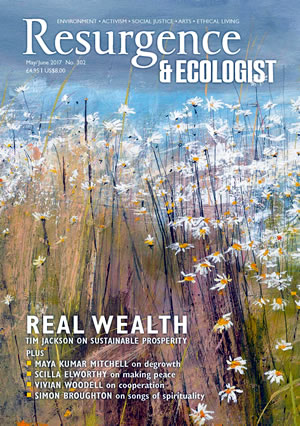Everyone, surely, likes solar power – free energy for ever, which can be converted to electricity increasingly cheaply. But what happens at night? Or when it’s overcast? Well, store it – and that’s getting cheaper too. The Switch, by Chris Goodall – interviewed in Resurgence & Ecologist Issue 300 – suggests that this combination of cheap solar photovoltaics and cheap batteries will be a global winner.
It is certainly true that the cost of PV solar has been falling rapidly, outstripping predictions, and even confounding most of the PV optimists, as the technology has improved and markets have built. Goodall sees this continuing, with PV soon becoming the dominant global energy source. Lithium-ion battery costs have also fallen significantly. So, with wind providing inputs when there is no sun, we are set for a green future.
That’s a bald summary of this exciting book, but, as ever, the devil is in the detail. PV cells have energy conversion efficiencies of between 10% and 24%, depending on the type, and overall load factors of at best 20% – that’s a measure of how much of their theoretical output (if they could run all the time at full power) is achieved in practice. For wind turbines the load factors range up to 40%, depending on location. Increasing PV cell efficiency won’t help much to change that imbalance: it’s mainly due to the fact that it gets dark at night.
Hence the importance of storage. However, you have to be careful with sales pitches. Tesla’s much-touted Powerwall domestic battery was initially marketed in the United States at US$3,000 for a 7kWh-rated unit, plus installation and inverter costs. That would store enough electricity to run a 1kW heater overnight (i.e. for seven hours), assuming the battery had been charged up from a suitably sized roof-top PV array during the day. Its latest model, Powerwall 2, is double the size and almost twice the cost. If there were little sun next day, or you needed more energy, then what? You would still need a grid link, possibly fed by wind power – or more batteries and maybe a larger PV array to charge them. This doesn’t mean that battery storage is silly, but it will have to get a lot cheaper to make sense for significant domestic use.
Goodall thinks it will, and he may be right. However, there are other storage options, mostly on the larger scale and requiring grid links. He mentions large-scale pumped hydro reservoir storage – the cheapest energy storage option at present. He also looks at other bulk storage options, such as compressed and liquefied air. These all provide ways to balance local variations in demand and supply across large numbers of users and a range of generators. So can the hydrogen option, which Goodall sees as especially significant: surplus wind or solar electricity can be used to electrolyse water to generate hydrogen gas, which can be stored ready to make electricity – or be converted, using captured carbon dioxide, to methane gas or other synthetic fuels, for heating or use in vehicles. Clever stuff!
So Goodall is right: there is an energy revolution, with new technology opening up many options, including for storage. That, he says, means solar can play a major role, even in countries with poor solar regimes like the UK. So, too, can long-distance electricity transmission from areas where solar is more available, traded with surplus power from wind and other renewables. That’s something Goodall doesn’t look at. But he does make it clear that a switch to green energy is not only possible, but well under way.








